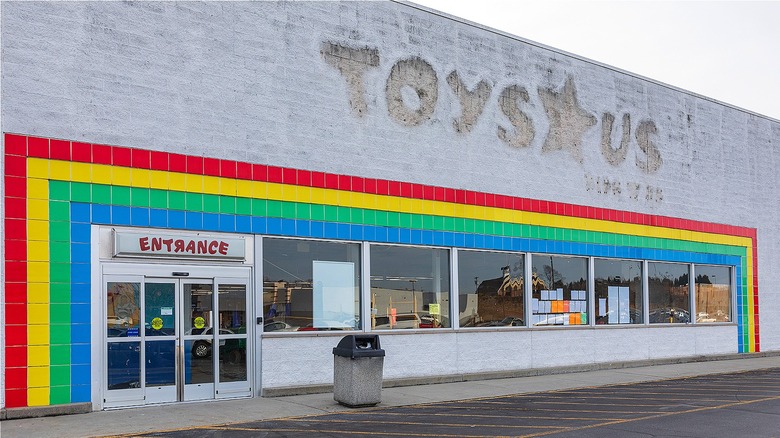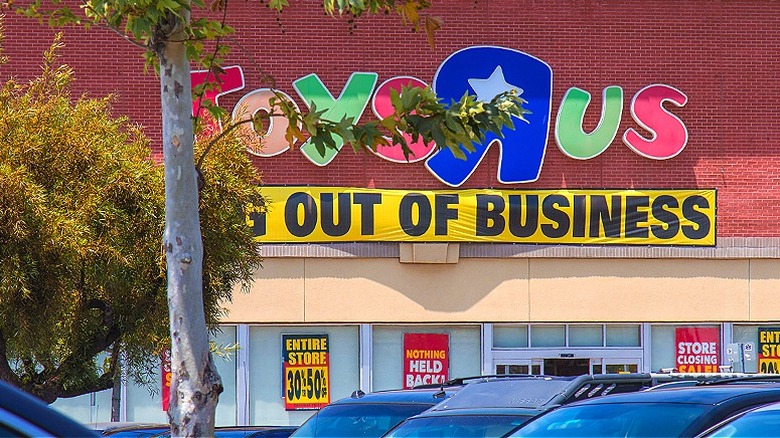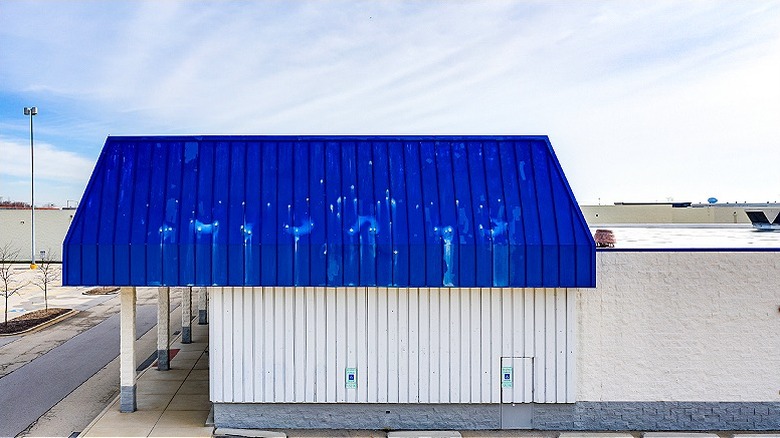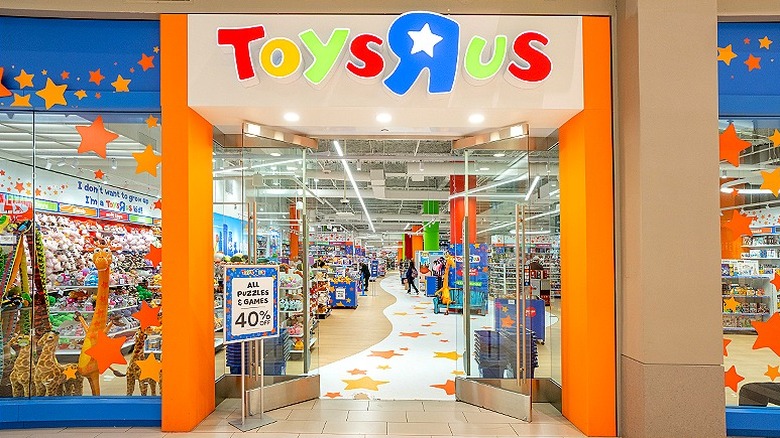What Happened To Toys 'R' Us After It Filed For Bankruptcy?
Were you a Toys 'R' Us kid? Whether you were spoiled with toys from the retailer or only went to Toys 'R' Us as a special gift, chances are the chain's name immediately floods your dopamine center with the joy of toys. Then perhaps the feeling of loss, hitting you like a ton of primary-colored bricks. Because in 2017, Toys 'R' Us filed for bankruptcy after years of debt and decline, almost 70 years after its initial founding as a kids' furniture store in 1948.
For decades, failure never seemed to be an option for the friendly neighborhood toy superstore that put smaller friendly neighborhood toy stores out of business. During its "category killer" supremacy in the 1980s and 1990s, Toys 'R' Us reigned supreme, if not in earnings, than in market share. But in 2018, practically overnight, hundreds of Toys 'R' Us stores were liquidated, closed, and seemingly left to rot.
Analysts were shocked at the time, not to mention consumers who knew Toys 'R' Us as a retail institution, rather than just a toy store. Still, for months during the chain's Chapter 11 era, Toys 'R' Us stores stood empty, a hollowed-out candy shell of its former fun and glory. What factors were really to blame for the bankruptcy? And would Toys 'R' Us ever play again, like a phoenix (or giraffe) rising from the ashes?
Contributing factors to the bankruptcy
Multiple factors contributed to the demise of Toys 'R' Us, and only one of them was the increasing shift of playtime focus from actual toys to screen time. A market for toys still existed in the late '90s and early 2000s, but Toys 'R' Us continued to fail to capture it. Don't believe us? Then check out this list of the most valuable Pokémon cards, rare Furbies that are worth a ton of money, and even the most rare collectible Barbies for further evidence.
No, a playtime paradigm shift wasn't the only competition Toys 'R' Us couldn't keep up with prior to its Chapter 11 filing. In addition to a rough final holiday season after its bankruptcy filing, the toy superstore struggled to stay relevant in a changing retail landscape. While Toys 'R' Us once trounced mom-and-pop competitors, it was challenged by even stronger e-commerce giants like Amazon and discount retailer super forces like Walmart.
With this said, a key factor in the Toys 'R' Us downfall can be attributed to its $6 billion leveraged buyout in 2005 by private equity firms Bain Capital, KKR & Co., and Vornado Realty Trust. While this buyout was supposed to help the company both reorganize and manage its debt, suppliers and consumers panicked. Debts skyrocketed, and maintenance was neglected. Post-buyout, Toys 'R' Us saw mismanagement, increasing debts, and an overall (and pronounced) decrease in store quality. In 2018, one year after filing for bankruptcy, Toys 'R' Us liquidated and closed its U.S. stores.
The years after bankruptcy
The lack of post-buyout investment in a pleasant in-store (or online) shopping experience would prove crucial to the chain's downfall. However, the Toys 'R' Us brand name was still considered valuable. So was its real estate. Party supply store Party City even temporarily took over some Toys 'R' Us stores in 2018 with "Toy City" pop-ups. Toys 'R' Us also showed up as a store-within-a-store at Kroger grocery stores during 2018. In 2019, the brand also briefly partnered with Target to power online sales. In 2020, Amazon was taken on as a fulfillment partner (the companies first worked together in 2005).
Toys 'R' Us then hired a New York firm to auction off its real estate holdings, and sold around $61 million in ground leases by 2019. The fact that one of the new private equity "saviors" of Toys 'R' Us was Vornado Realty only drew mild mention from the press at the time. Both the Toys 'R' Us brand name and IP were also planned for sale in 2018, but that auction was dramatically canceled.
In 2019, Tru Kids, the brand-name owners of Toys 'R' Us, partnered with tech startup b8ta to open two highly interactive mall stores: one in Houston, Texas, and another in Paramus, New Jersey. The concept stores were short-lived: In 2021, Tru Kids, Inc. announced the COVID-19 pandemic had forced it to shutter both of its last-standing U.S. locations.
Signs of life and future plans
Somehow, the pandemic didn't spell the final end of Toys 'R' Us. Instead, a controlling interest was sold to WHP Global in 2021. Soon after, WHP announced plans for reviving Toys 'R' Us, as well as its return to brightly colored brick-and-mortar toy stores.
"We're in the brand business, and Toys 'R' Us is the single most credible, trusted and beloved toy brand in the world," CEO of WHP, Yehuda Shmidman, told CNBC in 2021, adding, "We're coming off a year where toys are just on fire. ... And for Toys 'R' Us, the U.S. is really a blank canvas." Two years later, in 2023, WHP announced it would be opening 24 new flagship Toys 'R' Us stores in the U.S., as well as new shops in airports and on cruise ships. (Consider our pitch for naming those cruise ship stores "Ahoys 'R' Us.")
As for the 24 new flagship stores, their openings were slated to begin in 2024. Prior to this, a few new Toys 'R' Us flagships had already opened in two big malls — in New Jersey's American Dream Meadowlands Mall in 2021 and in Minneapolis' Mall of America in 2023. Also, in 2022, multiple new stores opened up inside of Macy's partner stores. According to WHP Global, the Toys 'R' Us brand generates $2 billion globally (across 31 countries) each year. While Toys 'R' Us is a case study of corporate neglect and bankruptcy gone wrong, its new life may just become a case study on the power of a well-told toy story.



